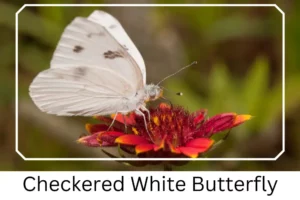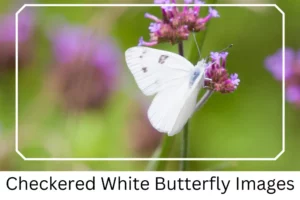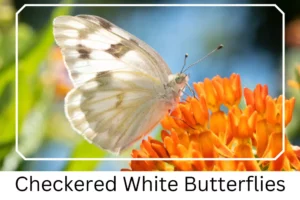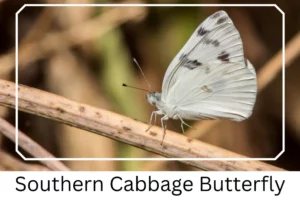Checkered White (Pontia protodice)
The Checkered White (Pontia protodice) is a captivating species of butterfly that graces the United States with its presence, particularly flourishing during the warm summer months. This small to medium-sized butterfly is known for its distinctive markings and adaptability to a wide array of environments, making it a subject of interest among enthusiasts and researchers alike.
Scientific Classification
- Family: Pieridae
- Genus: Pontia
- Common names: Southern Cabbage Butterfly
- Scientific Name: Pontia protodice
Overview
Frequenting a diverse range of habitats, from fields and pastures to urban vacant lots, the Checkered White butterfly exhibits a fascinating lifecycle that includes distinct stages from egg to adult. Each stage of its development offers unique characteristics that contribute to its survival and propagation. This guide aims to provide an in-depth look at the Checkered White butterfly, offering insights into its identification, lifecycle, and habits to enhance understanding and appreciation for this common yet remarkable species.
Description and Identification
Caterpillar
Known as a cabbage worm, the caterpillar stage of the Checkered White is identifiable by its pale greenish-gray body, adorned with three broken yellow lines down its back and scattered with both small and large black spots. Its body is also covered in fine hair-like growths, which adds to its distinctive appearance.
Pupa
The chrysalis phase is characterized by a pale gray to grayish white coloration, featuring very faint yellow patches and tiny black dots. It remains attached to the stem of its host plant, transitioning quietly into the next stage of its lifecycle.
Adult Butterfly
Sexual Dimorphism: This species exhibits a clear difference between males and females. Males display a checkered pattern in black on the outer half of their forewings, while females show a more heavily patterned appearance in brown, with diffused markings.
Color and Appearance: In flight or resting with wings open, the contrast between the sexes is evident. Both sexes have a white hindwing, but the patterns and colors vary significantly. With wings closed, males show a pale checkered pattern on their hindwings, and females display yellowish-tan markings.
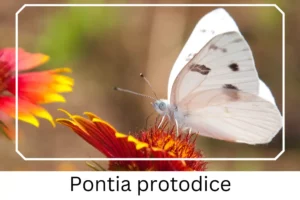
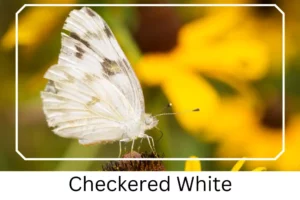 Average Wingspan: The Checkered White has an average wingspan ranging from 1.25–1.75 inches (3.2–4.4 cm), allowing for easy identification among other species.
Average Wingspan: The Checkered White has an average wingspan ranging from 1.25–1.75 inches (3.2–4.4 cm), allowing for easy identification among other species.
Flight Pattern: Despite its slow flight, the Checkered White maneuvers through the air with an erratic pattern, often seen fluttering among the flowers and plants it frequents.
Eggs
The eggs of the Checkered White are pale yellowish, elongated, and have a coarse texture. Laid singly, they undergo a color change to orange as they mature, signaling readiness for the next life stage.
Quick Facts | |
| Distribution | Predominantly found in the southern United States and northern Mexico. |
| Habitat | Thrives in a variety of environments including fields, pastures, sandy areas, and urban spaces. |
| Lifespan of Adults | Estimated to be about 6 to 9 months. |
| Host Plants | Prefers plants from the mustard and caper families. |
| Adult Diet | Primarily consumes nectar from mustards, composites, and alfalfa species. |
How to Identify Checkered White?
Identifying the Checkered White butterfly involves looking for specific markers across its lifecycle stages. During the caterpillar phase, search for a pale greenish-gray body with distinctive yellow lines and black spots. As it transitions into a pupa, note the pale gray chrysalis with faint yellow and black dots. Adult Checkered Whites can be distinguished by their sexual dimorphism: males with less pronounced black checkered patterns and females with more diffuse brown markings. Their erratic flight pattern and preference for nectaring on flowers of mustards, composites, and alfalfa are also telltale signs.
Did You Know?
- Unlike many other butterfly species, the Checkered White caterpillars have a preference for feeding on the buds, flowers, and fruits of their host plants rather than the leaves.
- This species has shown remarkable adaptability to urban environments, making it a common sight in city gardens and vacant lots.
Conclusion
The Checkered White butterfly is not only a beautiful sight in gardens and wild spaces but also an interesting subject for study due to its unique lifecycle and adaptability. By understanding how to identify this species and appreciating the intricate details of its existence, we can foster a deeper connection with the natural world. Observing the Checkered White in its natural habitat offers a window into the complex interactions within ecosystems and highlights the importance of preserving diverse habitats for the survival of such species.
Checkered White Pictures

Scientific Classification

- Family: Pieridae
- Genus: Pontia
- Common names: Southern Cabbage Butterfly
- Scientific Name: Pontia protodice

